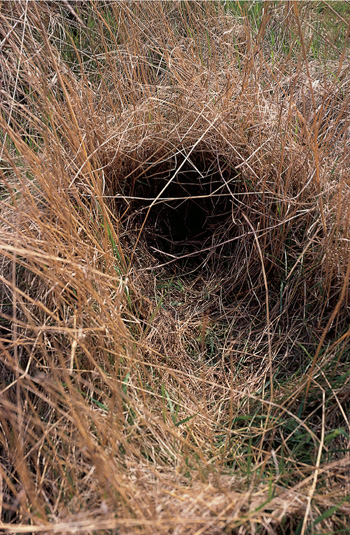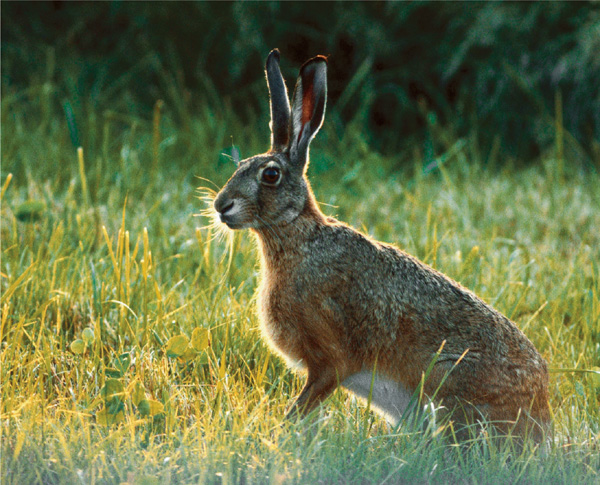
Lepus europaeus
The Brown Hare is dark brown above, light yellow-brown on its sides, and white on the belly. The ears are black-tipped, and the iris is light yellow. Brown Hare is about 55–70 cm long, and the tail, which measures about 10 cm, is black above and white below. It weighs 3.5–7 kg, with the female slightly larger than the male. You can find hares in all habitats, except for extensive areas of woodland.
Hares are common in open farmland near woods, hedges, and underbrush. They are mostly solitary and particularly active in the evening and at night, but in the mating season you can see small groups in fields even during the day.
Brown Hares have five toes on the front feet, but the innermost toe is so short that its imprint is only rarely visible. The hind foot is long and narrow and has four toes. All toes have narrow straight claws that are clearly visible in the tracks. Hares have no visible pads on their feet; instead, the soles are covered with a thick, insulating, feathery layer of hair. In the middle of the foot, this layer is particularly thick, getting sparser towards the front. This hair ensures the animal doesn’t fall over on smooth and slippery surfaces. The front footprint is 5–6 cm long and 3 cm wide; the hind footprints are 6–12 cm long and about 3.5 cm wide.
Brown Hare. AK.

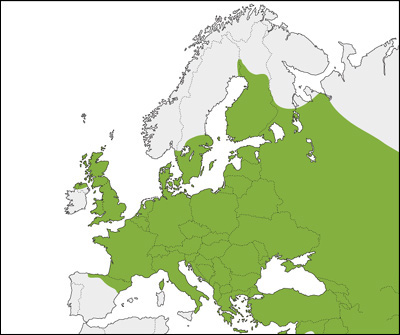
Brown Hare tracks in mud. Note the hair marks on the sole of the foot. PB.
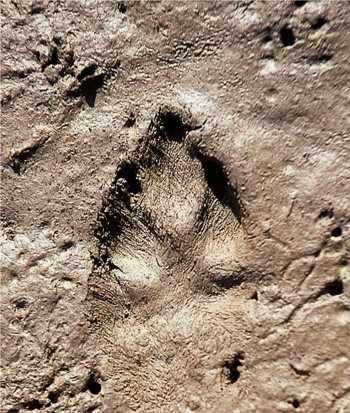
Brown Hares place their hind legs in front of their front legs when moving. Left, LG; right, Biopix.
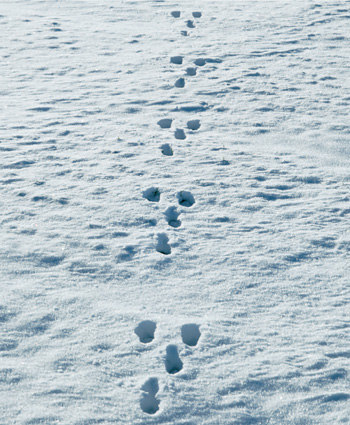
Hares normally move by hopping. They place one front leg immediately behind the other, in an almost straight line, in the direction they are moving, then swing the hind legs forward, around the front legs. The hind legs land almost simultaneously and leave two larger and longer marks ahead of the front feet, almost exactly one set of prints directly in front of the other. The faster the hare runs, the greater the distance between the tracks of the hind and front legs, as well as between groups of prints. At very high speeds, the hind footprints may be slightly offset.
Track of a Brown Hare, with the front feet behind the larger hind feet as the animal runs. LM.
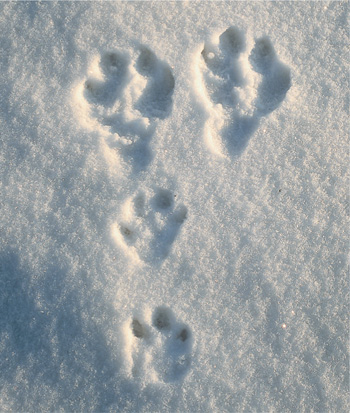
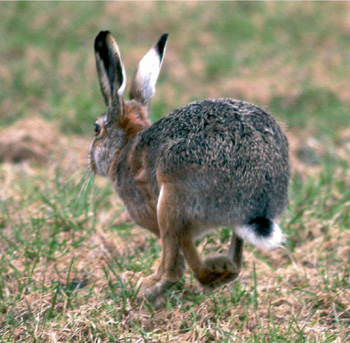
Brown Hares will follow the same trail for large distances, creating trails with trampled earth and vegetation as a result. Several hares might use the same trails, and the trails might also be used by other animals, including deer.
Hares often turn around and partially retrace their steps, then jump to one side and move in a completely different direction. This is particularly common when they are being pursued, and these sideways jumps allow them to change direction—by as much as 90 degrees—without losing speed. Over short distances, hares can reach speeds of up to 80 km per hour and jump up to 2.5 m.
When hares sit, they leave the long prints of the hind legs next to those of the front. During the day, hares often rest in depressions in the earth, called ‘forms’, which they create by scraping away vegetation with their feet. The form is usually long, and deep and wide towards the back end. You usually find clumps of grass or stones by the form, which provide a measure of protection for the resting animal. Hares sit with their hindquarters inside the form, with the hind legs tucked under the body and the front legs fully stretched out in front.
Hares are herbivores. In summer they eat succulent green plants, in winter a variety of fruits, particularly rose hips and hawthorn berries, but they may also eat turnips and the branches and bark of small trees, especially fruit trees. Their gnaw marks on trunks are deep and powerful. Trees that have been browsed in this fashion may, in time, be reduced to the size of dwarf bushes. Branches are bitten off with one smooth, oblique cut, as if by a knife.
The hare’s pill-shaped scat is oval and slightly flattened, with a diameter of 12–20 mm. Remains of their plant diet are easily recognisable in the scat, especially in winter. In winter the scat is light brown and very dry; in summer it is softer and darker. The scat can be almost completely black, and slightly pointed at one end. Unlike Rabbits, hares rarely use latrines, and scat can normally be found in areas where the animals eat. In these places you might see small mounds of scat, but hares also leave individual droppings in their tracks.
A Brown Hare’s winter scat. LG.

The Brown Hare’s large and visible ‘form’. AT.
